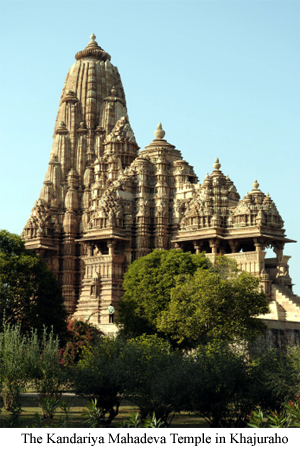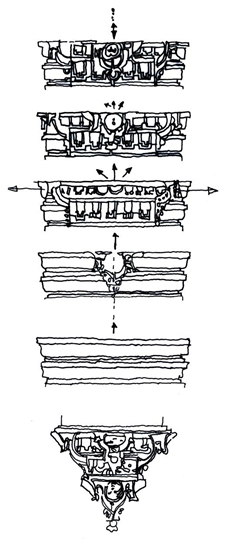Apr 18, 2025
Apr 18, 2025
Form and Function in Early Hindu Architecture
While the Gupta period brought about a classical period – or so it is said – in early Hindu culture, it is less clear how and why the temple developed as a form or typology. Indeed, from the early Vedic forest altars and temporary tree shrines, to the Buddhist rock cut monuments at Ajanta and Ellora, the early Hindu temple was nothing less than a revolution in typology – a free standing structure that was as symbolic as it was literal in its form. In this piece we look at some of the defining characteristics of the early Hindu temple.
 While the temple was to be later divided into two main streams – the Nagara style of the north and the Dravida style of the south, yet they shared many common features, the principal one among them being the temple structure itself as a representation and ‘communication channel’ with the cosmos. As Adam Hardy so eloquently puts it, Hinduism’s ‘polymorphous monotheism’ meant that the temple, even in its early iterations, was complex with many hidden layers of symbolism, transcending a mere physicality that was characteristic of Islamic or Judaeo-Christian forms that were to come later. The early Hindu temple was also restricted in terms of material – for the most part, terracotta, brick or mostly stone – were the principal items available to the mason and builder.
While the temple was to be later divided into two main streams – the Nagara style of the north and the Dravida style of the south, yet they shared many common features, the principal one among them being the temple structure itself as a representation and ‘communication channel’ with the cosmos. As Adam Hardy so eloquently puts it, Hinduism’s ‘polymorphous monotheism’ meant that the temple, even in its early iterations, was complex with many hidden layers of symbolism, transcending a mere physicality that was characteristic of Islamic or Judaeo-Christian forms that were to come later. The early Hindu temple was also restricted in terms of material – for the most part, terracotta, brick or mostly stone – were the principal items available to the mason and builder.
Returning to the early Hindu world view, the temple in its early form too shows the basic principles of Hindu thought – unity from dissolution, expansion, contraction and centrifugal movement – all basic tenets of the post Vedic philosophy. Another characteristic of temple architecture is its representational nature, in the sense that the entire body of the temple is made up of images, and not just of the gods in their niches, but rather as a whole scheme of abstract imagery with different levels of ease of perception. And a third characteristic must be that of association, or the connection of abstract meaning with form. And the temple is above all a visual spectacle, to be seen and felt, and not studied from a repository of historical documents. As the Brhad-Aranyaka Upanishada puts it (c.f. Adam Hardy):
Verily, truth is sight.
Therefore if two people should come disputing,
saying “I have seen”, “I have heard”,
we should trust the one
who says “I have seen”.
Function of the Temple
Form aside, the first purpose for the Hindu temple is to be the abode of the representation of God, often in the form of an icon or symbol installed within the heart of the structure. This innermost recess of the temple is the garbha griha, or the womb. Above this garbha griha rises a superstructure, or the shikhara, though it must be noted that the shikhara was a comparatively later development and early temples have rudimentary or no superstructures at all. This has been sometimes conceived to be a kind of secondary griha, a heavenly home to complement the earthly one in the garbha griha below.
Together the garbha griha and the shikhara constitute what is called the vimana in the Dravida style, and the mulaprasada in the Nagara style. It is here that the principal architectural decoration is found, as embodying the divinity inside, and it is here too that the main architectural expression of the building comes through. Without this decoration, early temple architecture would be nothing more than a ‘heap of masonry’, and it is the relatively plain interiors which make the temple so different from Western architecture which perceives volumes and is accustomed to the concept of interior ‘space’.
A few common features are the hallmarks of vimana architecture: the first is the orientation around the cardinal axes, with a main axis defining the doorway running from east to west, and a shorter one running north-south. These orientate the Vimana within an approximate square which is traced on the ground as a vastupurushamandala in a ritual fashion before construction starts.
It is to be noted that the temple itself consists of imagery, of wood construction translated into stone, of many small shrines combining into one whole which once again recalls the concept of ‘polymorphous monotheism’, with each small shrine being a miniature version of the whole of which it is a part. Another concept that comes through in the temple is the fact that the so-called ‘surface decoration’ is actually not to be thought of as a relief, but as an embedded or subsumed three dimensional form, once again being an integral part of the whole.
Movement and Dynamism
 The vimana also by its nature conveys a sense of movement or dynamism, as if it is under the thrall of some higher force. Its origin lies in the kalasa, or finial, at the summit of the temple, after which it moves downwards, along a vertical axis down the centre of the temple, and radiates outwards giving an appearance of ‘emergence and expansion’. This once again ties to the Hindu concept of the cosmos being in constant change and expansion, of radiating outwards from a point of origin. In a similar fashion the early Hindu shrine develops an idea of expansion and dissolution, of one form giving way to another, which dissolves into another form in its turn.
The vimana also by its nature conveys a sense of movement or dynamism, as if it is under the thrall of some higher force. Its origin lies in the kalasa, or finial, at the summit of the temple, after which it moves downwards, along a vertical axis down the centre of the temple, and radiates outwards giving an appearance of ‘emergence and expansion’. This once again ties to the Hindu concept of the cosmos being in constant change and expansion, of radiating outwards from a point of origin. In a similar fashion the early Hindu shrine develops an idea of expansion and dissolution, of one form giving way to another, which dissolves into another form in its turn.
In a further piece we will discuss the main features of this movement. Though later developments after the 9th and 10th centuries, especially in Dravida architecture, were to take these concepts further, the basis for these developments were laid as early as the temples of Deogarh and Bhitargaon, continuing further south as the Hindu kingdoms vied with each other for supremacy and power through conquest as much as through architecture and the arts.
Image (c) Gettyimages.com
Sketches by the author.
27-Oct-2013
More by : Ashish Nangia

|
Dear Ashish Nangia, I am really happy to read your interesting and educational article. I was inquiring about you with the Little India, New York magazine, because I read your article "Roots of Indian Architecture". I am a Nakhachitrakar - fingernail sculpted artist from New York. According to me "Nakhachitrakala" subject was teaching in the Takshashila and Nalanda university but not a single art history book or museum has given any reference or importance to this original fingernail art form which is created by humans (God-given fingernails as a basic tool to write and draw). I would like to educate people around the world about this unknown forgotten art technique, still exists today. It takes back at least to the 5th century AD, by whick time Kalidasa-the great play writer and port of the Sankrit language had mentioned that love letter written by Sakuntala on a lotus leaf with her fingernail in his play "The Recognition of Shakuntala". This reference shows that the people from India were using Nakha (fingernails) regularly for writing on leaves, but according to me "Nakhachitrakala (fingernail sculpted art technique) is originated in Ancient India. This art runs in my family and even today I can trace my family name from 1562. Once I will get your reply I will send you some printed articles to you by eamil. I want to give more exposure to my NakChitra. According to me first calligraphy and art form started with human fingernails. Please visit my website: suhas-tavkar.artistwebsites.com or you can just type my name on google.com and then go to Fine Art America website. Hope to get your response soon. Regards, Suhas Tavar Nakhachitrakar |